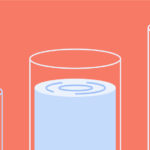Sure, you know hydration is important, but do you know how to hydrate properly for your unique needs? And do you know how to modify your hydration routine when fasting?
Water is an essential nutrient—meaning it’s needed for a variety of functions throughout the body like temperature regulation, waste removal, protection of tissues and joints, digestion, and muscle contraction just to name a few. Which is why we’re doing a deep dive on everything you need to know about staying hydrated in everyday life and during a fast.
How Much Should You Drink?
Water recommendations are highly individualized, and many people don’t actually need the recommended 8oz glasses 8 times a day. The amount of water you need is dependent on age, weight, body composition, gender, physical activity level, dietary practices, and even the environment you live in.
Water comprises 75% of body weight in infants, decreasing to 55% in the elderly population. Given that it comprises over half our body weight throughout life, it’s clearly an important nutrient for us to consume.
So how much water is “enough water?” Adequate hydration can be defined as having sufficient fluid to efficiently facilitate the bodily processes that require water to function. In contrast, dehydration means you are excreting more fluids than consumed, and bodily function may be compromised as a result. Evidence suggests that dehydration of as little as 2% of body weight can affect exercise performance, overall health in the elderly, gastrointestinal function, and the risk of urinary stone disease. Symptoms of dehydration include feeling very thirsty, dry mouth, urinating and sweating less than usual, dark colored urine, dry skin, fatigue, and dizziness.
While we certainly don’t want to be dehydrated, overhydration is also possible. It’s rare, and usually occurs in endurance athletes who consume water, but don’t supplement with enough electrolytes.
Estimating Your Fluid Needs
Since hydration amounts are quite nuanced for each individual, here’s what you should consider when calculating your daily needs:
- Consume 1 mL of fluid for every calorie you consume (1 mL/kcal)
- Weight should also be a factor when estimating fluid needs. Most people need 25-35 mL of fluids / kg of body weight. Try starting in the middle at 30 mL/kg and adjust from there based on your hydration assessment (which we’ll discuss next).
- Consider other factors like the amount of exercise you get, your climate, and unique medical conditions
Assessing Your Hydration
Once you’re consuming the “recommended” amount of fluids based on your estimates above, you should keep an eye on the following to see if you need to increase or decrease your fluid intake:
- Urine
- Color: If you’re unsure of your hydration level, and you aren’t taking any medications or supplements that change the color of your urine, you can check out the color on your next bathroom break to see how you’re doing. A concentrated yellow or yellowish-brown color likely means you’re dehydrated, very clear urine is a sign of overhydration, and a light straw color indicates you’re properly hydrated.
- Output: You can also track your urine output as an indicator of hydration. Measure total urine output and compare to the amount of fluids you consumed over the last 24 hours. On average, women should produce at least 1.13 +/- 0.42 liters per day (L/d) and men should produce 1.36 +/- 0.44 L/d urine.
- Skin
- Poor skin turgor (elasticity of your skin) = possible dehydration
- Dry skin = possible dehydration
- Dry mouth = possible dehydration
- Blood
- If you have the luxury of having bloodwork completed, there are specific labs that are indicators of hydration in healthy populations. Possible labs that indicate hydration are: increase in sodium, chloride, hematocrit, serum albumin, serum creatinine, serum urea, and serum osmolality.
- Thirst
- While this is a valid indicator of your fluid needs, keep in mind that thirst may not be triggered until dehydration levels are at 2-5% of body weight. So try to avoid thirst altogether if possible.
- Note: thirst isn’t a reliable indicator in those with conditions like hyperglycemia or kidney disease.
How to Modify Hydration on a Fast
For a 16:8 time-restricted feeding protocol (or other forms of TRF), a modification to your fluid intake may not be needed if you’re still consuming adequate food and fluids during your feeding window. Fluids consumed in the form of food count towards your total water intake. Some foods with high water content include: soup, broth, strawberries, celery, lettuce, spinach, pickles, and squash. However, if you find yourself eating less food in that window, then more water or other non-caloric beverages may be needed during your fasting window.
During a prolonged fast, external energy sources are low or non-existent, insulin levels drop, and as a result you start depleting glycogen stores and excreting more electrolytes. For each gram of glycogen your body stores about 3 grams of water. So, once glycogen starts to break down, that water will be lost. One study suggested a 0.5 kg fluid loss in a 65 kg adult over the course of a 36 hour fast.
However, it’s argued that total body water isn’t as important when assessing hydration, and functional water volume may be more clinically significant. The functional role of water has been defined as water used as the transport medium for blood components and metabolic products, and the regulation of metabolism. So, it may be assumed that the fluid loss from glycogen stores doesn’t affect the functional water levels in the body.
In addition, one study using a three day fast did not show any significant change in urine output when subjects were provided a standard amount of 2000 mL fluid per day along with sodium, potassium, and bicarbonate supplementation. This suggests that electrolyte supplementation is beneficial to maintaining hydration status. Especially during prolonged fasts, electrolyte supplementation is usually necessary due to increased losses as well.

While fluid loss on a fast may not be significantly more than feeding days, you still can be at risk of dehydration. Since a decent portion of our fluids come from our food, we have to make more of an effort to drink enough fluids during a fast to make up for the lost amount. It’s estimated that 20% of our fluids come from food. It’s also common to drink fluids with a meal or a snack, so if food is removed from our daily routine, we may not have that same trigger to drink liquids.
One tip is to track your fluid intake before and during a fast. Fluids (from beverages, not food) consumed before your fast can give you an estimate of your baseline needs. So, when you engage in a 24 hour or longer fast and are curious as to how much fluid you need, a good starting point might be taking your pre-fast baseline fluid intake and add 20% to it. From there, you can use markers of hydration status (shown above) to make additional adjustments. Another important point to keep in mind during your day to day (and especially during fasting days) is that increased sweat loss from strenuous labor, exercise, or environmental heat can raise fluid requirements 2 to 6 times the average need.
- The Complete Guide to Fat Burning - April 30, 2024
- Zero Live #4: 3 Ways to Boost Fat Burning - March 28, 2024
- Zero Live #3: Nutrition, Fast Breakers, and Fasting - March 11, 2024



